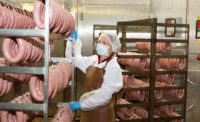Aggression In The Workplace
Barbara Young
byoung@stagnito.com
byoung@stagnito.com
Reportedly there are more than a half million men and women of all ages and ethnicity who make up the work force of the meat industry. Based on personal observations, gender representation on the production side of the business is pretty much evenly divided. Although such superficial characterizations are statistically important, workforce genotype offers more information about certain capabilities than phenotypes.
Question. Who is more ideal as a plant-floor supervisor — a man or a woman? The right answer is the person with the best credentials, the right attitude, and abundant patience. Anybody in a management or supervisory position knows what a trying job it is. Nonetheless, they must never forget the other side of the issue — some people should never have authority over another human being.
I’m reminded of a case involving my friend’s wife, who endured continued abuse from her boss at a small meat packing plant. She has a meat science degree, several years of experience — in quality assurance and at an ingredients company — and, as my friend and I both agree, she is a really nice person. My friend thinks the latter quality is her undoing. Her boss yelled, belittled, and made unreasonable requests of her. Why didn’t she just quit? Well, that’s for another column.
This discussion is about aggression in the workplace with exhibits from the American Meat Institute Foundation’s Annual Conference on Worker Safety Health & Human Resources.
One after another, a list of impressive speakers tackled the issue in some fashion. Of particular note, is the session on workplace violence presented by Dennis Davis, Ph.D., of FL-based Aon Risk Services Inc.
Another question. If you can’t control your own bad behavior, how can you be trusted to diffuse violent tendencies in the people you supervise? Insert your answer here.
We know workplace violence is no joke. We have situations in the industry to back this up. The overall statistics concerning workplace violence are astounding, however. Davis reported that 18,104 workplace injuries from assault happened in 2002 — 609 homicides. One in six violent crimes occurs at work — 7 percent of all rapes, 8 percent of all robberies, and 16 percent of all assaults.
Davis says you can’t manage what you can’t measure. Therefore, to deal with aggression one must first define it. The list includes verbal abuse, vandalism, bullying, sexual harassment, management-labor conflict, road- and air-rage, fist fighting, robbery, militancy and terrorism.
Moreover, effective aggression-control tactics are not altogether programmable. One can certainly learn proven techniques, but good instincts about human behavior can also come in handy. For example, body language communicates much about a person’s mindset, in addition to overt behavior.
Davis offers these warning signs of violent behavior: decreased or inconsistent productivity; social isolation and poor peer relationships; poor personal hygiene; and drastic changes in personality.
Fore warned is fore armed.
Not protecting and caring for employees is tantamount to not putting gasoline in vehicles and not changing the oil every 3,000 miles. Even a person inclined to aggression would not think of such carelessness. What to do about it? Regardless of your position in your organization, be watchful of those symptoms. The life you save could be your own. Enough said.


Report Abusive Comment